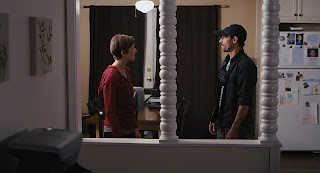Movie Review - La Bare
Joe Manganiello has been acting and filmmaking for 15 years. He became nationally and now internationally known when he was added to the cast of HBO's True Blood. He drew a lot of attention, not necessarily for his abilities as a thespian but more for his near nudity revealing a very muscular physique. As such, he was a perfect choice for Steven Soderberg's Magic Mike, the story of a male strip club. Now, probably because of the success of that film, Manganiello decided to get behind the camera for his feature debut and create this documentary on the real-life male strip club in Dallas, Texas, known as La Bare.
He interviews the owners and performers, the people who work behind the scenes, as well as the men who go on stage and take off their clothes for money. Chief among them is Randy "Master Blaster" Ricks. He began performing at La Bare in 1979 and purportedly he's the longest-running, male stripper in the Lone Star state and possibly all 49 others.
Master Blaster along with the dozen or so men interviewed who work at La Bare, the majority of whom are strippers, are not very interesting. The archetypes here are no more unique or diverse than in Magic Mike (2012). They're even less so than in The Full Monty (1997). Manganiello subtitles this documentary, "The True Stories Behind the Magic." Except, these aren't stories. These are loving, brief examples of sycophancy.
The owners of La Bare comment on the Las Vegas showmanship at play within, but, if that's the case, it must be the lamest Las Vegas has to offer. Manganiello doesn't compare and contrast La Bare to something like Thunder from Down Under, which has a lot more production value, stage lights and group choreography. Yet, even that basic Las Vegas show has more to offer than what we see in La Bare.
Another key difference between what Las Vegas and Broadway provides and what La Bare doesn't provide is genuine and trained talent. People who take to the stage in Las Vegas and Broadway are mostly people who have went to school for acting, singing and dancing.
One dancer at La Bare named JD who does a cop routine admits that he can't dance. Another dancer named Austin who does a vampire skit admits that he couldn't move to the beat either. Austin does do some slight acrobatics, but, if you've seen the singer Pink performing "Glitter in the Air" at the Grammys with the help of Cirque du Soleil, then Austin's routine is not as impressive.
At least, another dancer nicknamed Channing did some high school musicals and has experience acting. Yet, he's an aberration. Most talent seems to be drawn from amateur night, which brings a random assortment of guys with zero talent, out of which are plucked the most muscular and charismatic who are either horny for female adoration or desperate for money. One dancer-turned-DJ named Nick Adams admits he's in it simply to have sex with as many girls as possible.
Finally, a dancer named Cesar reveals he was a Texas Ranger who served in Afghanistan and Iraq. His interview opens the door to the only really compelling testimony. He talks about having fought for our country abroad and then not being able to find adequate work when he came home. This is a significant problem, but I wish Manganiello had put Cesar's solution in perspective. How many former service-members have been tempted with this option to use whatever skills learned in the military for stripping work?
Manganiello's film feels incredibly insulated, and is designed to praise these guys and this establishment. He is not at all concerned with challenging them. Master Blaster is one of the oldest male dancers, but why? Why aren't there more strippers in their 50's? Manganiello never asks the question of if Master Blaster is getting so old that maybe he should consider hanging up his g-string.
Manganiello certainly doesn't challenge the stereotypical idea presented here about what men want or what men get out of a strip club as opposed to women. Several comment that men just want the nudity or the sex only, whereas women want a show. This idea is perpetuated as if women and men are monolithic, particularly in this day and age.
One stripper named David says some girls are just horny, but it's a throwaway line in this movie. The character of Samantha, played by Kim Cattrall, in the HBO series Sex and the City took the character of Blanche Devereaux on The Golden Girls a step further revealing the reality that women like sex too and can like it divorced from the idea of romance or commitment.
One of the chief statements made in Lars Von Trier's Nymphomaniac is that his female protagonist isn't sick. She simply loves sex but exists in a world that punishes her for it. It was the same for Anna Faris in What's Your Number (2011). Films like Lady Chatterley's Lover or Butterfield 8 demonstrate that women can eschew romance and foreplay and detach those things from the sex act, sometimes as casually as men are portrayed doing.
However, many men don't detach as casually as they are always portrayed. Actor-turned-filmmaker Charlie David created a short TV documentary called I'm a Stripper (2013). He shot a follow-up this year that included a male stripper who performs for gay men. That Canadian stripper comments on the fact that many of his male clients want to cuddle and spend time with him doing things other than fornication.
For those that think this is an occurrence limited to homosexuals, Soderbergh even debunked this myth with The Girlfriend Experience (2009). Despite having a veritable porn star at hand, many men want the companionship and the romantic elements, and not just the sex. Manganiello has no wider view of this and no comprehension of his former director's body of work.
Brief words are conveyed from what appears to be the only African-American stripper here. There's a couple of Latino strippers, but diversity doesn't seem to be a huge concern. If Manganiello embraces any stereotype, the myth about black men should have been one.
Two Stars out of Five.
Not Rated but for mature audiences.
Running Time: 1 hr. and 30 mins.
He interviews the owners and performers, the people who work behind the scenes, as well as the men who go on stage and take off their clothes for money. Chief among them is Randy "Master Blaster" Ricks. He began performing at La Bare in 1979 and purportedly he's the longest-running, male stripper in the Lone Star state and possibly all 49 others.
Master Blaster along with the dozen or so men interviewed who work at La Bare, the majority of whom are strippers, are not very interesting. The archetypes here are no more unique or diverse than in Magic Mike (2012). They're even less so than in The Full Monty (1997). Manganiello subtitles this documentary, "The True Stories Behind the Magic." Except, these aren't stories. These are loving, brief examples of sycophancy.
The owners of La Bare comment on the Las Vegas showmanship at play within, but, if that's the case, it must be the lamest Las Vegas has to offer. Manganiello doesn't compare and contrast La Bare to something like Thunder from Down Under, which has a lot more production value, stage lights and group choreography. Yet, even that basic Las Vegas show has more to offer than what we see in La Bare.
Another key difference between what Las Vegas and Broadway provides and what La Bare doesn't provide is genuine and trained talent. People who take to the stage in Las Vegas and Broadway are mostly people who have went to school for acting, singing and dancing.
One dancer at La Bare named JD who does a cop routine admits that he can't dance. Another dancer named Austin who does a vampire skit admits that he couldn't move to the beat either. Austin does do some slight acrobatics, but, if you've seen the singer Pink performing "Glitter in the Air" at the Grammys with the help of Cirque du Soleil, then Austin's routine is not as impressive.
At least, another dancer nicknamed Channing did some high school musicals and has experience acting. Yet, he's an aberration. Most talent seems to be drawn from amateur night, which brings a random assortment of guys with zero talent, out of which are plucked the most muscular and charismatic who are either horny for female adoration or desperate for money. One dancer-turned-DJ named Nick Adams admits he's in it simply to have sex with as many girls as possible.
Finally, a dancer named Cesar reveals he was a Texas Ranger who served in Afghanistan and Iraq. His interview opens the door to the only really compelling testimony. He talks about having fought for our country abroad and then not being able to find adequate work when he came home. This is a significant problem, but I wish Manganiello had put Cesar's solution in perspective. How many former service-members have been tempted with this option to use whatever skills learned in the military for stripping work?
Manganiello's film feels incredibly insulated, and is designed to praise these guys and this establishment. He is not at all concerned with challenging them. Master Blaster is one of the oldest male dancers, but why? Why aren't there more strippers in their 50's? Manganiello never asks the question of if Master Blaster is getting so old that maybe he should consider hanging up his g-string.
Manganiello certainly doesn't challenge the stereotypical idea presented here about what men want or what men get out of a strip club as opposed to women. Several comment that men just want the nudity or the sex only, whereas women want a show. This idea is perpetuated as if women and men are monolithic, particularly in this day and age.
One stripper named David says some girls are just horny, but it's a throwaway line in this movie. The character of Samantha, played by Kim Cattrall, in the HBO series Sex and the City took the character of Blanche Devereaux on The Golden Girls a step further revealing the reality that women like sex too and can like it divorced from the idea of romance or commitment.
One of the chief statements made in Lars Von Trier's Nymphomaniac is that his female protagonist isn't sick. She simply loves sex but exists in a world that punishes her for it. It was the same for Anna Faris in What's Your Number (2011). Films like Lady Chatterley's Lover or Butterfield 8 demonstrate that women can eschew romance and foreplay and detach those things from the sex act, sometimes as casually as men are portrayed doing.
However, many men don't detach as casually as they are always portrayed. Actor-turned-filmmaker Charlie David created a short TV documentary called I'm a Stripper (2013). He shot a follow-up this year that included a male stripper who performs for gay men. That Canadian stripper comments on the fact that many of his male clients want to cuddle and spend time with him doing things other than fornication.
For those that think this is an occurrence limited to homosexuals, Soderbergh even debunked this myth with The Girlfriend Experience (2009). Despite having a veritable porn star at hand, many men want the companionship and the romantic elements, and not just the sex. Manganiello has no wider view of this and no comprehension of his former director's body of work.
Brief words are conveyed from what appears to be the only African-American stripper here. There's a couple of Latino strippers, but diversity doesn't seem to be a huge concern. If Manganiello embraces any stereotype, the myth about black men should have been one.
Two Stars out of Five.
Not Rated but for mature audiences.
Running Time: 1 hr. and 30 mins.











Comments
Post a Comment